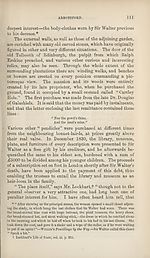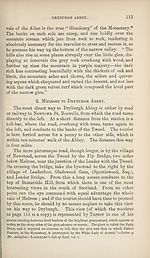Download files
Complete book:
Individual page:
Thumbnail gallery: Grid view | List view

112
EXCURSIONS FROM MELROSE.
when travelling in his boyhood with his father, from Selkirk
to Melrose, the old man suddenly desired the carriage to halt
at the foot of an eminence, and said, ‘ We must get out here,
Walter, and see a thing quite in your line.’ His father then
conducted him to a rude stone on the edge of an acclivity about
half a mile above the Tweed at Abbotsford, which marks the
spot—
‘ Where gallant Cessford’s life-blood dear
Reeked on dark Elliot’s border spear.’
This was the conclusion of the battle of Melrose, fought in 1526,
between the Earls of Angus and Home, and the two chiefs of
the race of Ker on the one side, and Buccleuch on the other,
in sight of the young King James V., the possession of whose
person was the object of the contest. This battle is often men¬
tioned in the Border Minstrelsy, and the reader will find a long
note on it under the lines which I have just quoted from the
Lay of the Last Minstrel. In the names of various localities
between Melrose and Abbotsford, such as Slcirmuhfield, Charge-
Law, and so forth, the incidents of the fight have found a lasting
record; and the spot where the retainer of Buccleuch terminated
the pursuit of the victors by the mortal wound of Ker of Cess-
ford (ancestor of the Dukes of Roxburghe), has always been
called Turn-again. In his own future domain the young min¬
strel had before him the scene of the last great Clan-battle of
the Borders.”
The tourist may return to Melrose by Turn-again, where
Sir Walter had a favourite seat, from which there is one of the
best views of the vale of Melrose.
A little to the east of Abbotsford, on the opposite bank of
the river, below the junction of the Gala, the Allan or Elwand
water runs into the Tweed. There can be little doubt that the
*When we bad ridden a little time on the moors, he said to me rather pointedly,
‘ I am going to show you something that I think will interest you; ’ and presently,
in a wild corner of the hills, he halted us at a place where stood three small ancient
towers, or castellated houses, in ruins, at short distances from each other. It was
plain, upon the slightest consideration of the topography, that one (perhaps any one)
of these was the tower of Glendearg, where so many romantic and marvellous adven¬
tures happen in the Monastery. While we looked at this forlorn group, 1 said to Sir
Walter that they were what Burns called ‘ ghaist-alluring edifices.’ ‘Yes,’ he answer¬
ed carelessly, ‘ 1 dare say there are many stories about them.’ As we returned, by
a different route, he made me dismount and take a footpath through a part of Lord
Somerville’s grounds, where the Elland runs through a beautiful little valley, the
EXCURSIONS FROM MELROSE.
when travelling in his boyhood with his father, from Selkirk
to Melrose, the old man suddenly desired the carriage to halt
at the foot of an eminence, and said, ‘ We must get out here,
Walter, and see a thing quite in your line.’ His father then
conducted him to a rude stone on the edge of an acclivity about
half a mile above the Tweed at Abbotsford, which marks the
spot—
‘ Where gallant Cessford’s life-blood dear
Reeked on dark Elliot’s border spear.’
This was the conclusion of the battle of Melrose, fought in 1526,
between the Earls of Angus and Home, and the two chiefs of
the race of Ker on the one side, and Buccleuch on the other,
in sight of the young King James V., the possession of whose
person was the object of the contest. This battle is often men¬
tioned in the Border Minstrelsy, and the reader will find a long
note on it under the lines which I have just quoted from the
Lay of the Last Minstrel. In the names of various localities
between Melrose and Abbotsford, such as Slcirmuhfield, Charge-
Law, and so forth, the incidents of the fight have found a lasting
record; and the spot where the retainer of Buccleuch terminated
the pursuit of the victors by the mortal wound of Ker of Cess-
ford (ancestor of the Dukes of Roxburghe), has always been
called Turn-again. In his own future domain the young min¬
strel had before him the scene of the last great Clan-battle of
the Borders.”
The tourist may return to Melrose by Turn-again, where
Sir Walter had a favourite seat, from which there is one of the
best views of the vale of Melrose.
A little to the east of Abbotsford, on the opposite bank of
the river, below the junction of the Gala, the Allan or Elwand
water runs into the Tweed. There can be little doubt that the
*When we bad ridden a little time on the moors, he said to me rather pointedly,
‘ I am going to show you something that I think will interest you; ’ and presently,
in a wild corner of the hills, he halted us at a place where stood three small ancient
towers, or castellated houses, in ruins, at short distances from each other. It was
plain, upon the slightest consideration of the topography, that one (perhaps any one)
of these was the tower of Glendearg, where so many romantic and marvellous adven¬
tures happen in the Monastery. While we looked at this forlorn group, 1 said to Sir
Walter that they were what Burns called ‘ ghaist-alluring edifices.’ ‘Yes,’ he answer¬
ed carelessly, ‘ 1 dare say there are many stories about them.’ As we returned, by
a different route, he made me dismount and take a footpath through a part of Lord
Somerville’s grounds, where the Elland runs through a beautiful little valley, the
Set display mode to:
![]() Universal Viewer |
Universal Viewer | ![]() Mirador |
Large image | Transcription
Mirador |
Large image | Transcription
| Antiquarian books of Scotland > Scotland/Scots > Black's picturesque tourist of Scotland > (172) |
|---|
| Permanent URL | https://digital.nls.uk/130030254 |
|---|
| Description | Thousands of printed books from the Antiquarian Books of Scotland collection which dates from 1641 to the 1980s. The collection consists of 14,800 books which were published in Scotland or have a Scottish connection, e.g. through the author, printer or owner. Subjects covered include sport, education, diseases, adventure, occupations, Jacobites, politics and religion. Among the 29 languages represented are English, Gaelic, Italian, French, Russian and Swedish. |
|---|

